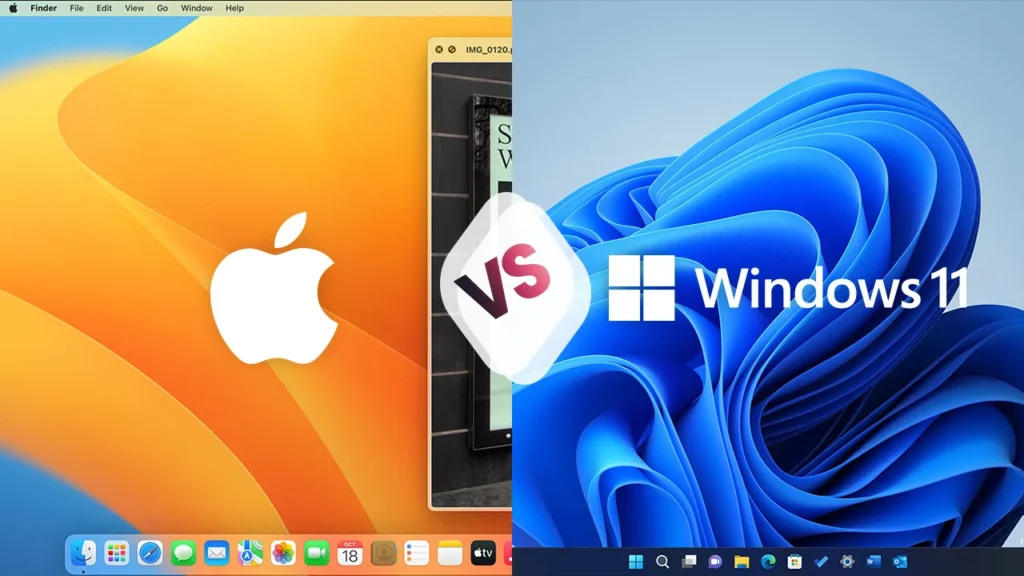[contact-form-7 id=”714″ title=”Test”]
In the dynamic realm of technology, operating systems are the bedrock of our digital engagements. Amidst the giants in this domain, two names – macOS and Windows – stand prominent. The enduring discourse between users of Mac and Windows has been a fixture in tech dialogues for generations. Each operating system comes with its distinct array of features, design principles, and user encounters. In this article, we’ll navigate through the fundamental disparities between macOS and Windows OS, shedding illumination on what sets them apart and aiding you in determining which one aligns best with your requisites.

User Interface and Design Philosophy:
One of the most discernible facets of macOS is its minimalist and elegant design. Apple places considerable emphasis on visual allure and user-friendly interfaces. The Dock, macOS’s taskbar, resides at the screen’s base, hosting app icons for easy accessibility. Moreover, the menu bar atop the screen grants swift entry to system functions and app settings. The overall design exudes coherence and concentration, delivering a seamless experience.
Contrarily, Windows OS adopts a more diversified approach. Over time, Windows has undergone multiple design evolutions, with each version presenting a unique user interface. Windows 10, for instance, introduced the Start Menu, amalgamating the familiarity of the classic menu with the live tile interface from Windows 8. This assortment enables users to select a style resonating with their inclinations, albeit potentially yielding a less uniform visual encounter.
Software Compatibility:
The availability of software assumes pivotal significance when electing an operating system. Traditionally, Windows has held an edge in this aspect owing to its larger market share. Consequently, a greater number of software developers have catered to the Windows platform, yielding a broader spectrum of applications and games compatible with Windows OS.
macOS, while gaining ground recently, still trails in terms of sheer software diversity. Nonetheless, the divide is narrowing, particularly with the emergence of software compatibility layers like Apple’s Rosetta, facilitating the operation of select Intel-based apps on the newer M1-powered Macs. It’s vital to factor in your precise software requirements while deliberating between the two platforms.
Hardware Ecosystem:
Apple’s oversight over both hardware and software facets of its ecosystem begets a tightly integrated experience on macOS devices. This governance results in optimized performance and battery life, endowing MacBooks with a reputation for reliability. The advent of Apple Silicon has amplified this integration; the M1 chip’s prowess delivers remarkable performance and power efficiency.
In contrast, Windows OS caters to a gamut of hardware configurations due to its open ecosystem. This versatility empowers users to select from diverse manufacturers, specifications, and price points, guaranteeing a Windows device for every budget and need. However, this diversity occasionally engenders disparities in performance and compatibility.
Customization vs. Simplicity:
Windows OS flourishes in the realm of customization. Users can extensively personalize their desktops, taskbars, and other UI elements. This level of adaptability resonates with those who relish tailoring their digital milieu to echo their preferences.
In juxtaposition, macOS embraces a more controlled approach to customization, prioritizing simplicity and uniformity. While some might perceive this as constraining, others find solace in the absence of clutter and the harmonious aesthetic across all applications.
Final Verdict:
The selection between macOS and Windows OS ultimately hinges on your priorities and inclinations. If you cherish a suave and harmonized user experience, prioritize software security, and are open to investing in Apple’s ecosystem, macOS might be your compass. Conversely, if software compatibility, hardware versatility, and customization avenues top your list, Windows OS could be your compass.
Both operating systems wield strengths and vulnerabilities, and the decision often narrows down to what syncs better with your workflow, software prerequisites, and personal preferences. Irrespective of your course, the realm of technology promises an exhilarating expedition replete with innovations and prospects.